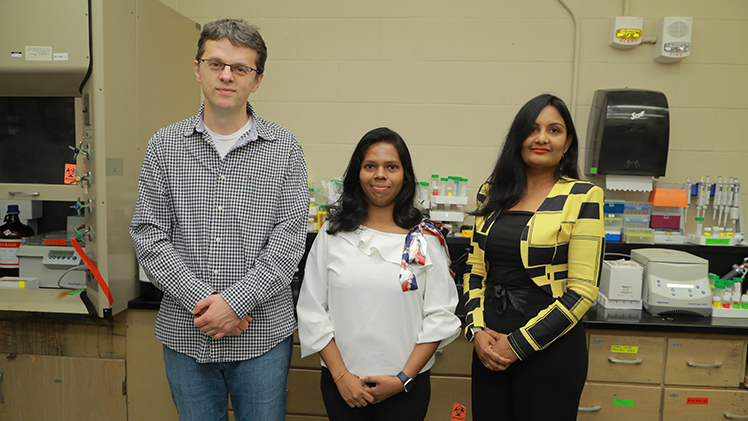University of Toledo researchers are attuned to the idiosyncrasies of harmful algal blooms in western Lake Erie, where they join water treatment plant operators each summer in monitoring them around the clock to protect the region’s drinking water.
Questions, however, remain about how biological interactions in the lake ecosystems drive the formation and decline of these blooms, and how these interactions change under the presence of different organic and inorganic nutrients.

Dr. Dragan Isailovic, from left, professor in UToledo’s Department of Chemistry and Biochemistry, is joined by doctoral candidate Sanduni Premathilaka and postdoctoral researcher Sharmila Thenuwara as co-authors on a recent research article in the International Society of Microbial Ecology Journal.
Scientists at California’s Lawrence Livermore National Laboratory (LLNL) led by Dr. Xavier Mayali have been seeking answers to these questions, alongside collaborators at The University of Toledo and the University of Michigan. The International Society of Microbial Ecology Journal recently published the team’s most recent findings, exploring how harmful algal blooms can grow using organic nitrogen, which enters the watershed through the decomposition of aquatic and terrestrial organisms or from organic fertilizers.
“Ultimately we’re trying to better understand and predict bloom dynamics and toxicity,” said Dr. Dragan Isailovic, a professor in UToledo’s Department of Chemistry and Biochemistry, who lent his expertise in cyanotoxin analysis to the project. “The more we know about the production of cyanotoxins during these blooms, the better equipped we will be to mitigate their negative effects.”
Researchers have long known that inorganic nutrients fuel harmful algal blooms of the globally abundant freshwater cyanobacterium microcystis, which is recognized as the major producer of the toxins microcystins that annually threatens the drinking water supply in western Lake Erie. Cyanobacterial harmful algal blooms are usually linked to excessive inorganic phosphorus and nitrogen, both of which are found in fertilizer.
“But nitrogen is now emerging as a limiting nutrient in these ecosystems, especially during algal blooms, where its availability often restricts the growth of cyanobacteria,” said LLNL’s Dr. Wei Li, who is the lead author of the research published in the International Society of Microbial Ecology Journal. “Most studies have focused on inorganic forms of nitrogen such as nitrate and ammonium, but the role of organic molecules in fueling harmful algal blooms is not well-characterized. Organic nitrogen, which includes compounds like amino acids, proteins and urea, could be a significant source of nitrogen for algal blooms, but its dynamics and impact are less well-understood. This gap in knowledge prevents our ability to predict and manage harmful algal blooms effectively, as organic nitrogen sources might play a critical role in sustaining these blooms.”
Researchers monitored the growth, microcystin production and microbiome community structure of several microcystis strains from algal blooms in Lake Erie. They used microbiome transplant experiments, cyanotoxin analysis and nanometer-scale stable isotope probing to measure nitrogen incorporation and exchange at single-cell resolution.
The results they report in their research article indicate that organic nitrogen input could potentially support microcystis blooms and toxin production in nature, and the microcystis-associated microbial communities likely play critical roles in this process. However, these hypotheses will require additional testing by the team directly in Lake Erie.
The research collaboration reflects the close ties between UToledo and LLNL, which signed a collaboration agreement last fall. The agreement calls for the institutions to exchange science and technology ideas, to support student opportunities and internships and to pursue research and development in areas like solar energy and other renewable energy technologies, climate and environmental science, biomedical sciences and hydrogen production and storage.
“This project to gain a better understanding of the role of the cyanobacterial microbiome in the growth of harmful algal blooms in Lake Erie and other waterways in northwest Ohio is one of a number of critical science and engineering challenges UToledo is tackling with LLNL,” said Dr. Frank Calzonetti, vice president for innovation and economic development at UToledo. “UToledo is a leader in water quality research, and our scientists are benefitting greatly through our access to one of the top research facilities in the world.”
UToledo doctoral candidate Sanduni Premathilaka and postdoctoral researcher Sharmila Thenuwara join Isailovic as co-authors, as does Dr. David Baliu-Rodriguez, who graduated from UToledo with a doctorate in chemistry in 2021 and is now a staff scientist at LLNL.
The work was funded by LLNL’s Laboratory Directed Research and Development program.